
Arhopala silhetensis, the Sylhet oakblue, is a small butterfly found in India that belongs to the lycaenids or blues family. The species was first described by William Chapman Hewitson in 1862.

Arhopala birmana, the Burmese bushblue, is a species of lycaenid or blue butterfly found in the Indomalayan realm.
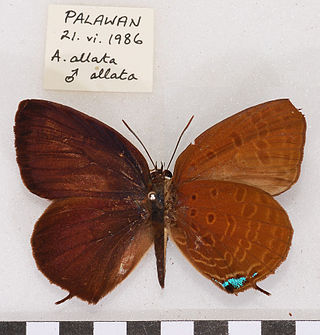
Arhopala allata is a butterfly of the family Lycaenidae. It is found in Asia.

Arhopala aedias, the large metallic oakblue, is a species of butterfly belonging to the lycaenid family described by William Chapman Hewitson in 1862. It is found in Southeast Asia.
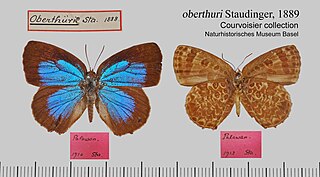
Arhopala alaconia is a species of butterfly belonging to the lycaenid family described by William Chapman Hewitson in 1869. It is found in Southeast Asia.

Arhopala ammonides is a species of butterfly belonging to the lycaenid family described by William Doherty in 1891. It is found in Southeast Asia.

Arhopala amphimuta is a species of butterfly belonging to the lycaenid family described by Cajetan Felder and Rudolf Felder in 1860. It is found in Southeast Asia - Peninsular Malaya, Sumatra, Borneo, Bangka, the Philippines, Thailand, Mergui, Burma, Langkawi, Penang and Java.

Arhopala arvina, the purple-brown tailless oakblue, is a species of butterfly belonging to the lycaenid family. It was described by William Chapman Hewitson in 1869. It is found in Southeast Asia.

Arhopala atosia is a species of butterfly belonging to the lycaenid family described by William Chapman Hewitson in 1869. It is found in Southeast Asia - Borneo, Sumatra, Bangka, Pulau Laut, Thailand, Indochina, Peninsular Malaya, Singapore, Burma, Langkawi, Mergui and Palawan.

Arhopala aurea is a species of butterfly belonging to the lycaenid family described by William Chapman Hewitson in 1862. It is found in Southeast Asia.

Arhopala corinda is a species of butterfly belonging to the lycaenid family described by William Chapman Hewitson in 1869. It is found in Southeast Asia.
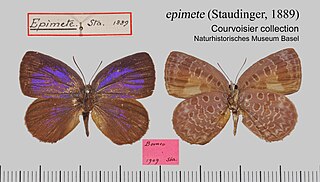
Arhopala epimete, the violetdisc oakblue, is a species of butterfly belonging to the lycaenid family described by Otto Staudinger in 1889. It is found in Southeast Asia.

Arhopala admete is a butterfly in the family Lycaenidae. It was described by William Chapman Hewitson in 1863. It is found in the Australasian realm,

Arhopala paraganesa, the dusky bushblue, is a butterfly in the family Lycaenidae. It was described by Lionel de Nicéville in 1882. It is found in the Indomalayan realm.
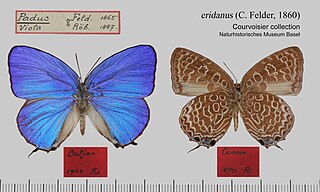
Arhopala eridanus is a butterfly in the family Lycaenidae. It was described by Cajetan Felder in 1860. It is found in the Indomalayan realm.
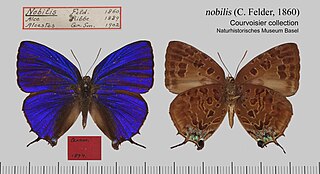
Arhopala nobilis is a butterfly in the family Lycaenidae. It was described by Cajetan Felder in 1860. It is found in the Australasian realm

Arhopala thamyras is a butterfly in the family Lycaenidae. It was described by Carl Linnaeus in 1758. It is found in the Australasian realm.

Arhopala tameanga is a butterfly in the family Lycaenidae. It was described by George Thomas Bethune-Baker in 1896. It is found in the Indomalayan realm where it is endemic to Borneo.

Arhopala hercules is a butterfly in the family Lycaenidae. It was described by William Chapman Hewitson in 1862. It is found in the Australasian realm. |

Arhopala phaenops, is a butterfly in the family Lycaenidae. It was described by Cajetan Felder and Rudolf Felder in 1865. It is found in the Indomalayan realm.





















